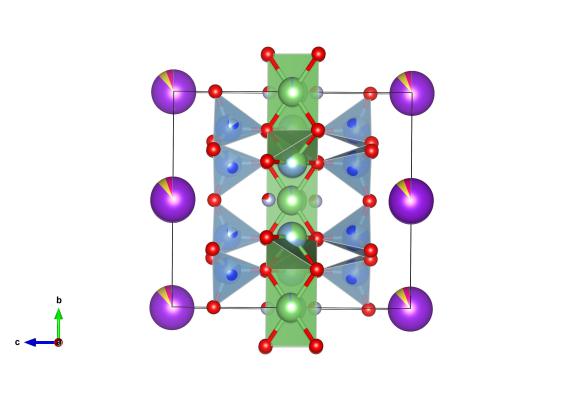Where does all the lithium come from? – Lepidolite
What does it look like?

The structure of lepidolite. The blue and red polyhedra are the alumina-silicate layers, with the green atoms representing the lithium that substitutes into the layers. The big purple atoms represent principally potassium, but also other alkali metals can be sandwiched in the layers. Image generated by the VESTA (Visualisation for Electronic and STructural analysis) software http://jp-minerals.org/vesta/en/
What is it?
Most of us now constantly walk around with some sort of electronic device, be it a mobile phone, a tablet or even now a watch. One of the reasons that we're able to do this is because of the advances in battery technology, mostly in lithium-ion batteries. We've heard about lithium-ion batteries, and how they are put together (crystallographically) on the blog a couple of times before. But the question remains, where are we getting all the lithium to make these batteries with?
You'll remember from high-school science, when you (or your teacher) threw a piece of lithium into some water, just how reactive this element is. It doesn't like to be on its own, so you'll never find a lump of lithium metal ready to be mined out. (In fact very few elements do occur 'native' like this; gold is probably the best known one.) Much of the lithium metal that is used in industry is extracted from the Earth in two ways. One is that it is filtered from brine and mineral spring water, and the other is that it can be extracted from some igneous minerals.
One of these minerals is Lepidolite, which is a sheet silicate and part of the mica family, like the mineral muscovite. However, the layers of lepidolite are a little more complex, as instead of the middle aluminium atoms many of these are replaced by lithium. Also sandwiched in between the layers you can find many of the other alkali metals (cesium, rubidium and potassium). As well as being the source of much of the world's lithium metal, lepidolite was also the mineral that the element rubidium was first isolated and discover from by Bunsen and Kirchhoff (presumably with the aid of a Bunsen burner!).
Where did the structure come from?
This structure of lepidolite was determined from a specimen found in Italy, and is #9009586 in the Crystallography Open Database.






